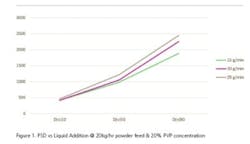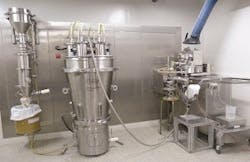To better monitor and understand process variables and their effect on wet granule size at the outlet of a twin screw granulator, Innopharma Labs and University of Ghent, Belgium, recently conducted a trial to evaluate the performance of an Eyecon Particle Characterizer. An integration system was developed by the University of Ghent, which allowed the Eyecon to capture and analyze images of the granules without interrupting the vacuum transfer line to the continuous drier. The measured material could therefore be fully dried and captured at the process end for further offline analysis.
EXPERIMENTAL PLAN
An experimental plan was drawn up to test three separate process variables:
1. Liquid Addition Rate – The rate at which liquid ingredients are added into the granulator’s barrel.
2. Powder Flow Rate (P.F.) – The rate at which solid ingredients are added to the process.
3. Binder Concentration – The concentration (v/v) of binder in the added liquid.
A total of 15 experiments were conducted within a five-hour period. The variables changed are shown in the Table 1.
Changed Variables
MATERIALS & EQUIPMENT
Lactose powder, granulated with water and liquid PVP as binder served as the test formulation. These ingredients were chosen for their wide availability and common usage in a variety of pharmaceutical formulations.
Continuous granulation and drying was carried out using a GEA Consigma 25 twin screw system. Developed by GEA, the system supports pharmaceutical manufacturers in their move to smaller-footprint continuous manufacturing lines as an alternative to less-efficient but commonly used batch manufacturing processes. This is a move being strongly driven by the FDA, as properly controlled continuous manufacturing lines are recognized as allowing greater control over finished product quality and ultimately greater patient safety.
Images of the particles captured by the Eyecon during these three runs visually demonstrate the variation in particle size.
Wet granulate was measured using a PAT (Process Analytical Technology) developed by Innopharma Labs. The Eyecon Particle Characterizer’s non-product-contact design permits straightforward integration with manufacturing equipment, either in-process or at material outlets, and allows for real-time monitoring and control of particle size. A custom integration system jointly designed by University of Ghent and Innopharma Labs was used to transfer the material, under vacuum, to the drying phase and, at the same time, consistently present the wet granulated material in-line monitoring.
HIGH LEVEL RESULTS
High-level results from examining the change in particle size with changing liquid addition rates are presented in Figure 1. Extended work examining the effects of all varied parameters has been published by the University of Ghent.
The graph in Figure 1 displays the change in D10, D50 and D90 values for the real-time measured granulate with respect to the three different liquid addition rates tested. Clearly it can be seen from the graph that there is an overall size increase corresponding to the increase in liquid addition rate.
It also appears that this increase is most pronounced in the larger particle sizes, with the D90 moving from 1884µm at 15g/min to 2445µm at 25g/min, while the D10 only moves from 416µm to 460µm under the same conditions. It has been suggested that this may be linked to the bimodal nature of twin screw granulation, where changes in particle size tend to primarily affect the larger particles, leaving the finer material a similar size (however, decreasing the overall volume of finer material).
Through a custom fabricated inspection port the effects of process variables on wet granulation can be determined with accuracy via Innopharma Labs particle characterization technology. Watch a video of this technology in action here.
Innopharma Lab’s analytical technology proved to be an effective instrument for in line measurement of the particle size distribution directly after twin screw wet granulation. The change in particle size was tracked directly during processing and provided particle size data and direct images of the particles in real time.
The sample presentation integration device developed by University of Ghent offers an excellent basis for a commercial-scale integration for Innopharma Lab’s PAT. However, future models will incorporate changes to reduce intermittent or potential window fouling issues. This was not a major issue during testing and experienced primarily during equipment start-up when the window occasionally became coated with dry powder. Depending on the application, a potential solution could take the form of either a small nozzle providing laminar airflow over the imaging area, or in systems more sensitive to airflow balance, a mechanical wiper.










